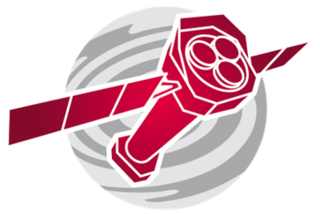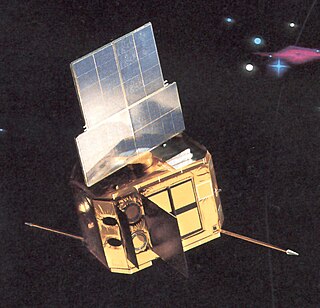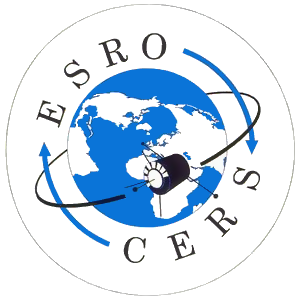Related Research Articles

The European Space Agency is an intergovernmental organisation of 22 member states dedicated to the exploration of space. Established in 1975 and headquartered in Paris, ESA has a worldwide staff of about 2,200 in 2018 and an annual budget of about €4.9 billion in 2023.

The Guiana Space Centre, also called Europe's Spaceport, is a European spaceport to the northwest of Kourou in French Guiana, a region of France in South America. Kourou is located approximately 310 mi (500 km) north of the equator, at a latitude of 5°. In operation since 1968, it is a suitable location for a spaceport because of its equatorial location and open sea to the east.

XMM-Newton, also known as the High Throughput X-ray Spectroscopy Mission and the X-ray Multi-Mirror Mission, is an X-ray space observatory launched by the European Space Agency in December 1999 on an Ariane 5 rocket. It is the second cornerstone mission of ESA's Horizon 2000 programme. Named after physicist and astronomer Sir Isaac Newton, the spacecraft is tasked with investigating interstellar X-ray sources, performing narrow- and broad-range spectroscopy, and performing the first simultaneous imaging of objects in both X-ray and optical wavelengths.

The National Centre for Space Studies is the French government space agency. Its headquarters are located in central Paris and it is under the supervision of the French Ministries of Defence and Research.

BepiColombo is a joint mission of the European Space Agency (ESA) and the Japan Aerospace Exploration Agency (JAXA) to the planet Mercury. The mission comprises two satellites launched together: the Mercury Planetary Orbiter (MPO) and Mio. The mission will perform a comprehensive study of Mercury, including characterization of its magnetic field, magnetosphere, and both interior and surface structure. It was launched on an Ariane 5 rocket on 20 October 2018 at 01:45 UTC, with an arrival at Mercury planned for on 5 December 2025, after a flyby of Earth, two flybys of Venus, and six flybys of Mercury. The mission was approved in November 2009, after years in proposal and planning as part of the European Space Agency's Horizon 2000+ programme; it is the last mission of the programme to be launched.

The Japan Aerospace Exploration Agency (JAXA) is the Japanese national air and space agency. Through the merger of three previously independent organizations, JAXA was formed on 1 October 2003. JAXA is responsible for research, technology development and launch of satellites into orbit, and is involved in many more advanced missions such as asteroid exploration and possible human exploration of the Moon. Its motto is One JAXA and its corporate slogan is Explore to Realize.

The Italian Space Agency is a government agency established in 1988 to fund, regulate and coordinate space exploration activities in Italy. The agency cooperates with numerous national and international entities who are active in aerospace research and technology.
Terma A/S is a Danish weapon and aerospace manufacturer for both civilian and military applications, and is owned by the Danish company Thrige Holding A/S. It is Denmark's largest company within the aerospace and the defense industry, employing approximately 1,100 people worldwide.

The European X-ray Observatory Satellite (EXOSAT), originally named HELOS, was an X-ray telescope operational from May 1983 until April 1986 and in that time made 1780 observations in the X-ray band of most classes of astronomical object including active galactic nuclei, stellar coronae, cataclysmic variables, white dwarfs, X-ray binaries, clusters of galaxies, and supernova remnants.

The European Space Research Organisation (ESRO) was an international organisation founded by 10 European nations with the intention of jointly pursuing scientific research in space. It was founded in 1964. As an organisation ESRO was based on a previously existing international scientific institution, CERN. The ESRO convention, the organisations founding document outlines it as an entity exclusively devoted to scientific pursuits. This was the case for most of its lifetime but in the final years before the formation of ESA, the European Space Agency, ESRO began a programme in the field of telecommunications. Consequently, ESA is not a mainly pure science focused entity but concentrates on telecommunications, earth observation and other application motivated activities. ESRO was merged with ELDO in 1975 to form the European Space Agency.

The Instituto Nacional de Técnica Aeroespacial «Esteban Terradas» is an autonomous agency of the Spanish public administration dependent on the Secretariat of State for Defence (SEDEF). It is responsible for the aerospace, aeronautics, hydrodynamics, and defense and security technologies research.

Ørsted is an Earth science satellite launched in 1999 to study the earth's geomagnetic field. It is Denmark's first satellite, named after Hans Christian Ørsted (1777–1851), a Danish physicist and professor at the University of Copenhagen, who discovered electromagnetism in 1820.

Artemis was a geostationary earth orbit satellite (GEOS) for telecommunications, built by Alenia Spazio for ESA. The Artemis satellite operated at the 21.5E orbital position until 2016, when it was moved to 123E to cover the L-Band spectrum rights for Indonesia's Ministry of Defense.
The French space program includes both civil and military spaceflight activities. It is the third oldest national space program in the world, after the Soviet and American space programs, and the largest space program in Europe.

Ariane 6 is a European expendable launch system currently under development since the early 2010s by ArianeGroup on behalf of the European Space Agency (ESA). It is intended to replace the Ariane 5, as part of the Ariane launch vehicle family. The stated motivation for Ariane 6 was to halve the cost compared to Ariane 5, and increase the capacity for the number of launches per year.
Airbus Defence and Space is the division of Airbus SE responsible for the development and manufacturing of the corporation's defence and space products, while also providing related services. The division was formed in January 2014 during the corporate restructuring of European Aeronautic Defence and Space (EADS), and comprises the former Airbus Military, Astrium, and Cassidian divisions. It is the world's second-largest space company after Boeing and one of the top ten defence companies in the world.

The Science Programme of the European Space Agency is a long-term programme of space science and space exploration missions. Managed by the agency's Directorate of Science, The programme funds the development, launch, and operation of missions led by European space agencies and institutions through generational campaigns. Horizon 2000, the programme's first campaign, facilitated the development of eight missions between 1985 and 1995 including four "cornerstone missions" – SOHO and Cluster II, XMM-Newton, Rosetta, and Herschel. Horizon 2000 Plus, the programme's second campaign, facilitated the development of Gaia, LISA Pathfinder, and BepiColombo between 1995 and 2005. The programme's current campaign since 2005, Cosmic Vision, has so far funded the development of ten missions including three flagship missions, JUICE, Athena, and LISA. The programme's upcoming fourth campaign, Voyage 2050, is currently being drafted. Collaboration with agencies and institutions outside of Europe occasionally occur in the Science Programme, including a collaboration with NASA on Cassini–Huygens and the CNSA on SMILE.
Cosmic Vision is the third campaign of space science and space exploration missions in the Science Programme of the European Space Agency (ESA). Formulated in 2005 as Cosmic Vision: Space Science for Europe 2015–2025, the campaign succeeded the Horizon 2000 Plus campaign and envisioned a number of missions in the fields of astronomy and solar system exploration beyond 2015. Ten missions across four funding categories are planned to be launched under Cosmic Vision, with the first being CHEOPS in December 2019. A mission to the Galilean moons (JUICE), the first deep space mission with an opportunistic target, and one of the first gravitational-wave space observatories (LISA), are planned for launch as part of the Cosmic Vision campaign.